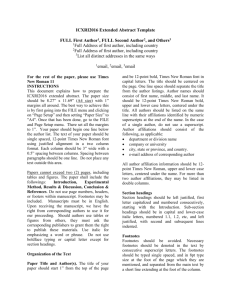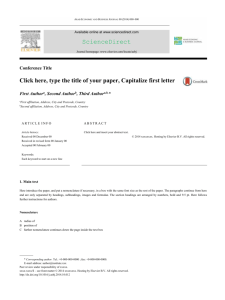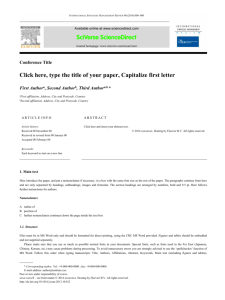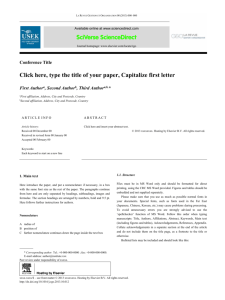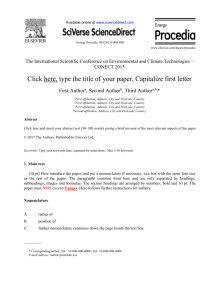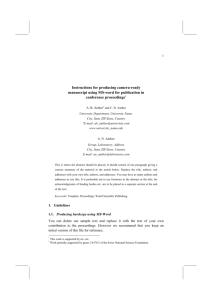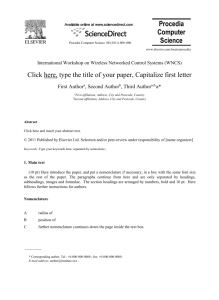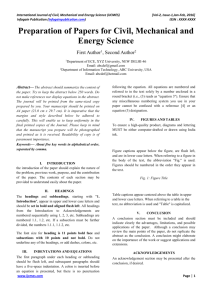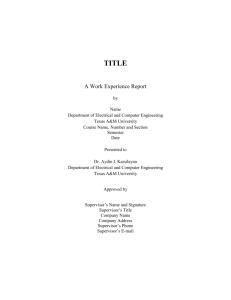Title of Paper
advertisement
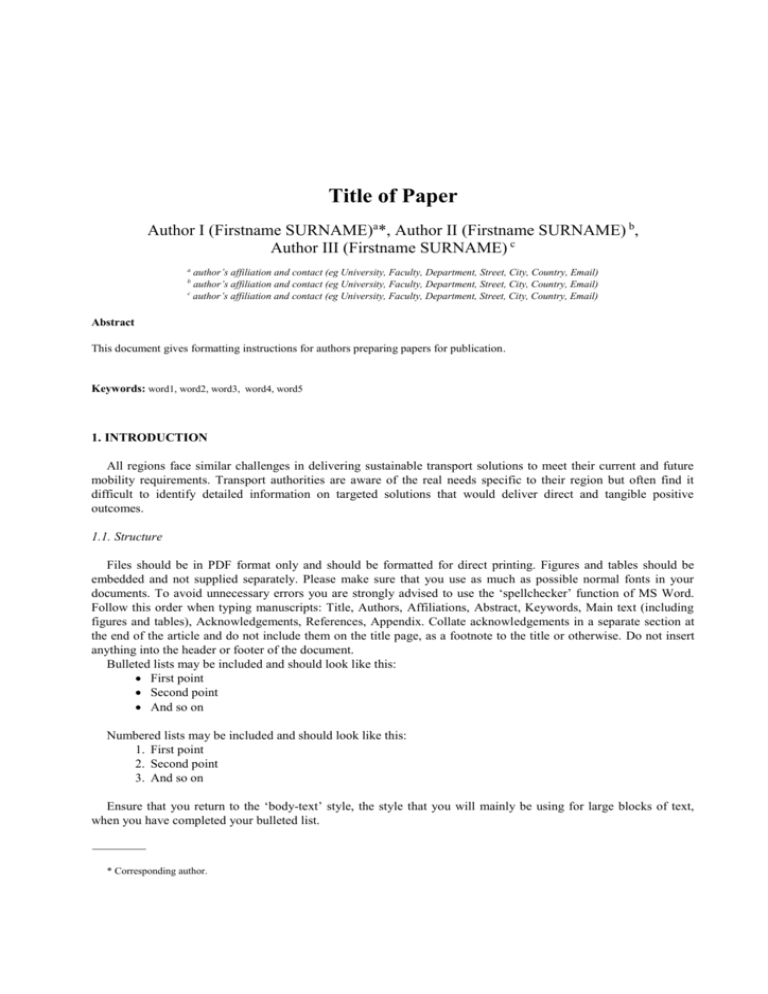
Title of Paper Author I (Firstname SURNAME)a*, Author II (Firstname SURNAME) b, Author III (Firstname SURNAME) c author’s affiliation and contact (eg University, Faculty, Department, Street, City, Country, Email) author’s affiliation and contact (eg University, Faculty, Department, Street, City, Country, Email) c author’s affiliation and contact (eg University, Faculty, Department, Street, City, Country, Email) a b Abstract This document gives formatting instructions for authors preparing papers for publication. Keywords: word1, word2, word3, word4, word5 1. INTRODUCTION All regions face similar challenges in delivering sustainable transport solutions to meet their current and future mobility requirements. Transport authorities are aware of the real needs specific to their region but often find it difficult to identify detailed information on targeted solutions that would deliver direct and tangible positive outcomes. 1.1. Structure Files should be in PDF format only and should be formatted for direct printing. Figures and tables should be embedded and not supplied separately. Please make sure that you use as much as possible normal fonts in your documents. To avoid unnecessary errors you are strongly advised to use the ‘spellchecker’ function of MS Word. Follow this order when typing manuscripts: Title, Authors, Affiliations, Abstract, Keywords, Main text (including figures and tables), Acknowledgements, References, Appendix. Collate acknowledgements in a separate section at the end of the article and do not include them on the title page, as a footnote to the title or otherwise. Do not insert anything into the header or footer of the document. Bulleted lists may be included and should look like this: First point Second point And so on Numbered lists may be included and should look like this: 1. First point 2. Second point 3. And so on Ensure that you return to the ‘body-text’ style, the style that you will mainly be using for large blocks of text, when you have completed your bulleted list. * Corresponding author. Please do not alter the formatting and style layouts which have been set up in this template document. As indicated in the template, papers should be prepared in single column format suitable for direct printing onto A4 paper (192mm x 262 mm). Do not number pages on the front, as page numbers will be added separately for the preprints and the Proceedings. Leave a line clear between paragraphs. All the required style templates are provided in this document with the appropriate name supplied, e.g. choose 1. 1st-head for your first order heading text, abstract-text for the abstract text etc. 1.2. Tables All tables should be numbered with Arabic numerals. Headings should be placed above tables, left justified. Leave one line space between the heading and the table. Only horizontal lines should be used within a table, to distinguish the column headings from the body of the table, and immediately above and below the table. Tables must be embedded into the text and not supplied separately. Below is an example which authors may find useful. Table 1. An example of a table An example of a column heading Column A (t) Column B (T) And an entry 1 2 And another entry 3 4 And another entry 5 6 1.3. Construction of references References should be listed at the end of the paper. Authors should ensure that every reference in the text appears in the list of references and vice versa. Some examples of how your references should be listed are given at the end of this template in the ‘References’ section which will allow you to assemble your reference list according to the correct format and font size. 1.4. Section headings Section headings should be left justified, with the first letter capitalized and numbered consecutively, starting with the Introduction. Sub-section headings should be in capital and lower-case italic letters, numbered 1.1, 1.2, etc, and left justified, with second and subsequent lines indented. You may need to insert a page break to keep a heading with its text. 1.5. General guidelines for the preparation of your text Avoid hyphenation at the end of a line. Symbols denoting vectors and matrices should be indicated in bold type. Scalar variable names should normally be expressed using italics. Weights and measures should be expressed in SI units. 1.6. Footnotes Footnotes should be avoided if possible. Necessary footnotes should be denoted in the text by consecutive superscript letters. The footnotes should be typed single spaced, and in smaller type size (8pt), at the foot of the page in which they are mentioned, and separated from the main text by a short line extending at the foot of the column. The ‘footnote’ style is available in this template for the text of the footnote. 2. Author Artwork All figures should be numbered with Arabic numerals (1,2,...n). All photographs, schemas, graphs and diagrams are to be referred to as figures. Line drawings should be good quality scans or true electronic output. Low-quality scans are not acceptable. Figures must be embedded into the text and not supplied separately. Lettering and symbols should be clearly defined either in the caption or in a legend provided as part of the figure. Figures should be placed at the top or bottom of a page wherever possible, as close as possible to the first reference to them in the paper. The figure number and caption should be typed below the illustration in 8pt and left justified. Artwork has no text along the side of it in the main body of the text. However, if two images fit next to each other, these may be placed next to each other to save space, see Fig 1. They must be numbered consecutively, all figures, and all tables respectively. Fig. 1. (a) first picture; (b) second picture Equations and formulae should be typed and numbered consecutively with Arabic numerals in parentheses on the right hand side of the page (if referred to explicitly in the text), ∮𝑠 𝐵 ∙ 𝑑𝑆 = 0 (1) They should also be separated from the surrounding text by one space. Acknowledgements These and the Reference headings are in bold but have no numbers. Text below continues as normal. References [1] Van der Geer, J., Hanraads, J. A. J., & Lupton, R. A. (2000). The art of writing a scientific article. Journal of Scientific Communications, 163, 51 - 59. [2] Strunk, W., Jr., & White, E. B. (1979). The elements of style (3rd ed.). New York: Macmillan. [3] Mettam, G. R., & Adams, L. B. (1994). How to prepare an electronic version of your article. In B. S. Jones, & R. Z. Smith (Eds.), Introduction to the electronic age (pp. 281-304). New York: E-Publishing Inc. Appendix A. An example appendix Authors including an appendix section should do so after References section. Multiple appendices should all have headings in the style used above. They will automatically be ordered A, B, C etc. A.1. Example of a sub-heading within an appendix There is also the option to include a subheading within the Appendix if you wish.
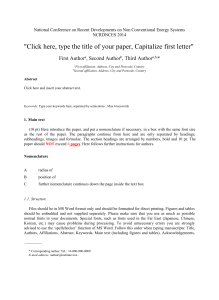
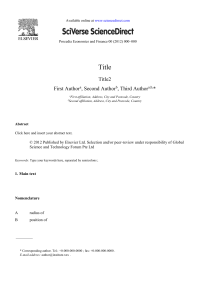
![Abstracts_files/Template_Full_Paper_PPEPPD2016[2]](http://s3.studylib.net/store/data/006986283_1-1c902679c64614beba0f844d40330ee7-300x300.png)
